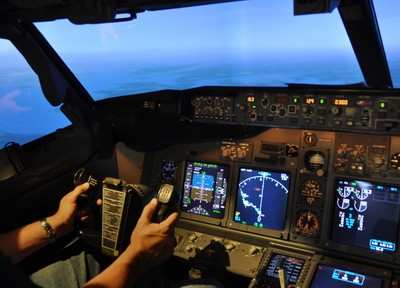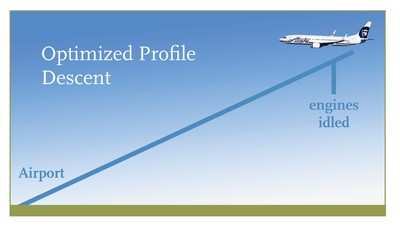NextGen Approach Procedures Are The Heart Of The
Experiment
This summer Alaska Airlines began testing next-generation flight
procedures at Seattle-Tacoma International Airport (Sea-Tac) that
will allow the airline and its sister carrier, Horizon Air, to
reduce their environmental impact during airport approaches. Dubbed
"Greener Skies," the project in cooperation with the Port of
Seattle, The Boeing Company and the FAA is focused on using
satellite-based flight guidance technology pioneered by Alaska
Airlines to descend more efficiently and reduce aircraft fuel
consumption, emissions and noise in the Puget Sound region. The
airline is seeking FAA approval for the procedures, which could
ultimately be used by all properly equipped carriers at
Sea-Tac.

Testing began June 16 on an Alaska Airlines Boeing 737-700
aircraft during a noncommercial flight. Using satellite guidance
technology called Required Navigation Performance (RNP), the plane
flew a consistent and controlled approach to Sea-Tac with pinpoint
accuracy, reducing flight-path length, ground noise and
greenhouse-gas emissions, and saving time and fuel.
The efficient, continuous descent approaches at Sea-Tac enabled
by this next-generation technology will benefit Seattle in several
ways. Alaska Airlines estimates the procedures will cut fuel
consumption by 2.1 million gallons annually and reduce carbon
emissions by 22,000 metric tons, the equivalent of taking 4,100
cars off the road every year. In addition, they will reduce
overflight noise exposure for an estimated 750,000 people living
within the affected flight corridor.

"These improved flight procedures at Sea-Tac will help Alaska
Airlines and Horizon Air minimize the environmental impact of our
flying on the communities we serve," said Gary Beck, Alaska's vice
president of flight operations. "With FAA approval, we hope the
procedures will be available to all carriers and gradually
integrated into the Seattle air traffic system. This project could
also become a blueprint for expanded use of next-generation
technology at more U.S. airports."
Typically, commercial aircraft approach follow a lengthy
approach pattern and series of stair-step descents before landing.
Using RNP technology and a continuous descent, also called an
optimized profile descent (OPD), aircraft can descend from cruise
altitude to an airport runway along a shorter, more direct flight
path at low power.
"This effort aligns with the Port of Seattle's commitment to
operate the greenest airport in the nation," said Mark Reis,
managing director of Seattle-Tacoma International Airport. "With
Alaska and Horizon representing nearly half of the daily operations
at Sea-Tac, this program not only benefits our regional environment
but also helps the airlines to operate more efficiently at Sea-Tac.
We are working closely with Alaska, Boeing and the FAA to ensure
these benefits are realized by our community as quickly as
possible."

Alaska Airlines pioneered RNP precision flight-guidance
technology during the mid-1990s to help its planes land at some of
the world's most remote and geographically challenging airports in
the state of Alaska. RNP provides computer-plotted landing paths
with pinpoint accuracy by using a combination of onboard navigation
technology and GPS satellites. It improves safety and reliability
in all weather, and reduces reliance on ground-based navigation
aids. Alaska Airlines currently uses FAA-approved RNP procedures at
23 U.S. airports.
Alaska Airlines is the only major U.S. air carrier with a
completely RNP-equipped fleet and fully trained crews. Alaska is
also the first airline approved by the FAA to conduct its own RNP
flight validation. Horizon Air's fleet soon will be fully
RNP-equipped as well.

Planning and testing of the procedures will continue through the
remainder of the year. They will be integrated into Alaska Airlines
and Horizon Air's commercial operations at Sea-Tac pending FAA
approval, which the airlines hope to obtain in 2010.
 ANN's Daily Aero-Term (05.05.24): Omnidirectional Approach Lighting System
ANN's Daily Aero-Term (05.05.24): Omnidirectional Approach Lighting System Aero-News: Quote of the Day (05.05.24)
Aero-News: Quote of the Day (05.05.24) Airborne 05.06.24: Gone West-Dick Rutan, ICON BK Update, SpaceX EVA Suit
Airborne 05.06.24: Gone West-Dick Rutan, ICON BK Update, SpaceX EVA Suit Airborne 05.03.24: Advanced Powerplant Solutions, PRA Runway Woes, Drone Racing
Airborne 05.03.24: Advanced Powerplant Solutions, PRA Runway Woes, Drone Racing Aero-News: Quote of the Day (05.06xx.24)
Aero-News: Quote of the Day (05.06xx.24)






